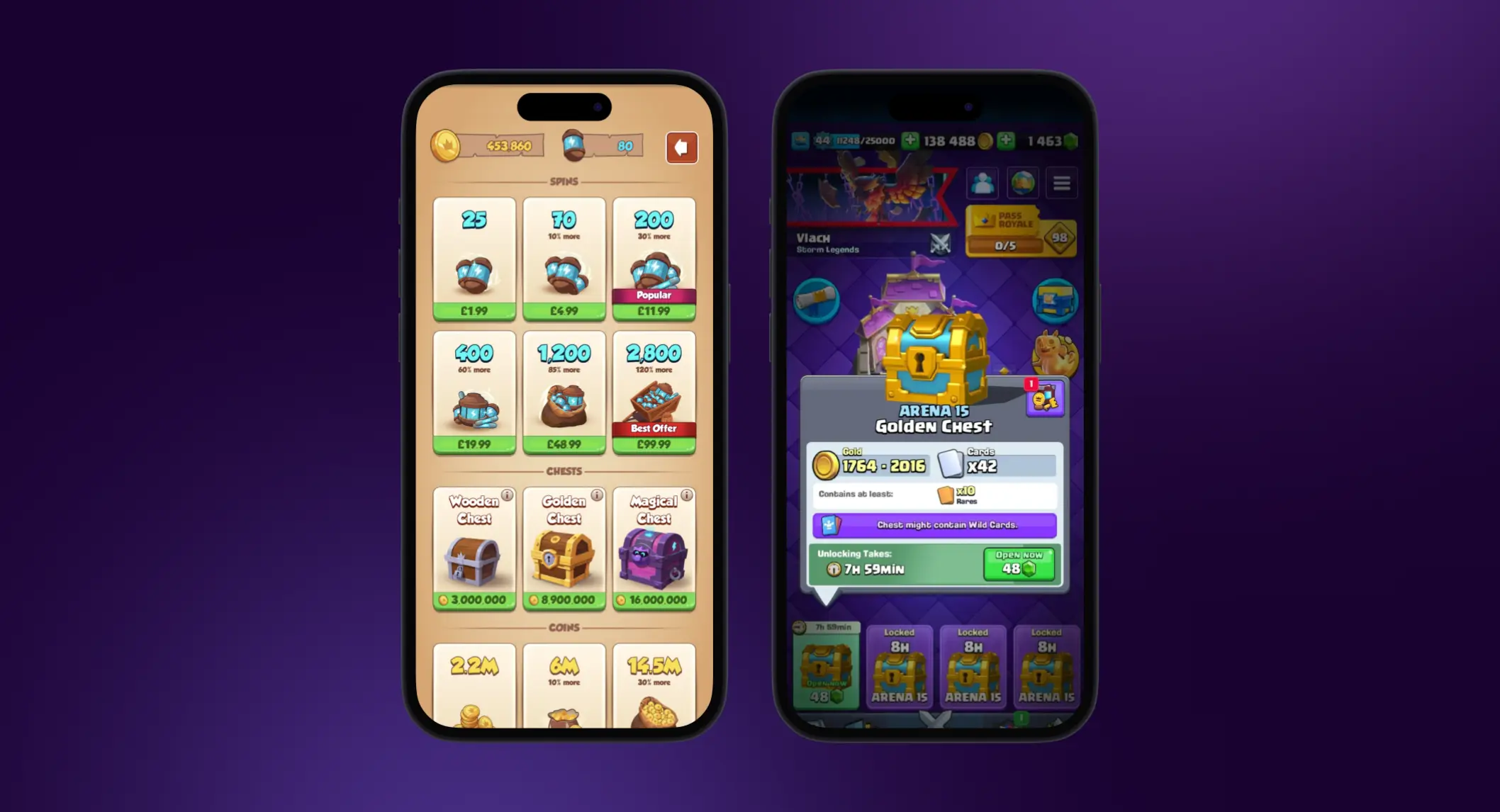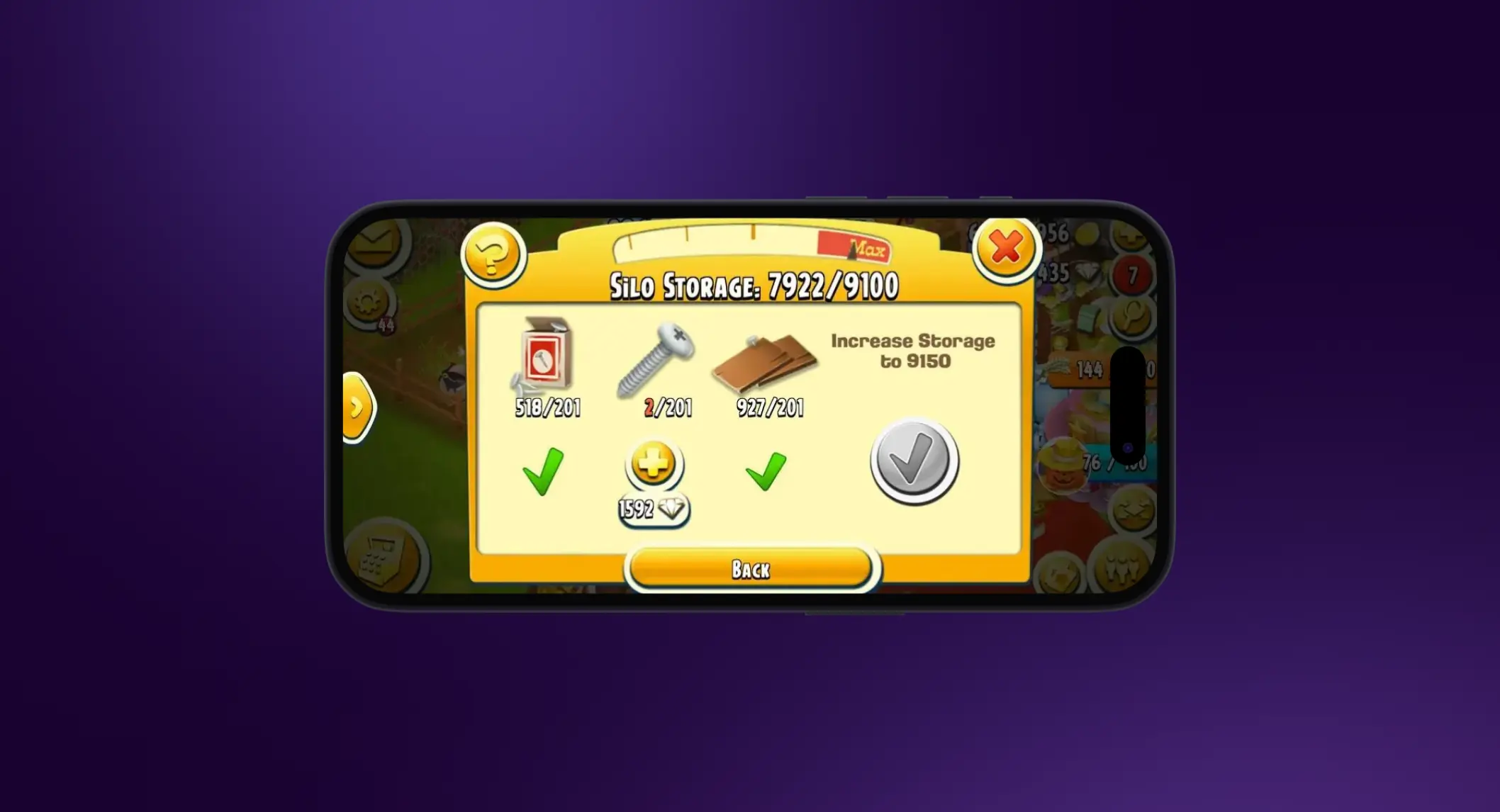Mobile
Revenue
User engagement
Player motivations to purchase: Time-saving
September 6, 2024•6 min
This blog series explores the motivations driving players to purchase, applicable both in-game and on the web. You are likely already using most of these incentives in the game, and this series will help you understand how these mechanics can work for web purchases and how to implement them effectively.
There are six primary player motivations: time-saving, efficiency-boosting, user experience optimization, vanity, social pressure, and additional content.
Today, we’ll examine which mechanics trigger time-saving motivation and how you can leverage it to drive purchases in your own Web Shop.


 Loyal players who've already spent significant time in your game or follow community advice will understand when and what the game might offer a time-saving option. For them, even a situational offer, such as one related to losing a battle, won't feel unexpected. They will plan to use it to maximize their benefit. And time-saving offers like that can be placed not only in-game but also in your web shop. Your players' desire for a better deal will outweigh the complexity of additional steps.
Let's look at a real example. Our partner has a 4x strategy game based on a popular IP (involving dragons). Players need currency to purchase in-game offers. In turn, in-game offers are tied to a time-saving motivation, as they accelerate construction or army crafting to win battles and capture new resources.
Our partner's web shop sells only currency packages, focusing on offering loyal players bundles of currency worth more than $100. Those bundles account for 50% of their web shop's total sales. Why? Because buying currency via the web shop is better for the player: the more expensive the bundle, the greater the benefit (up to 20% more currency included).
Ultimately, over 40% of the total volume of currency sold runs through the web shop. The economy is simple. Players receive more benefits, the developer saves on fees, and player metrics are increased through more expensive bundles.
Loyal players who've already spent significant time in your game or follow community advice will understand when and what the game might offer a time-saving option. For them, even a situational offer, such as one related to losing a battle, won't feel unexpected. They will plan to use it to maximize their benefit. And time-saving offers like that can be placed not only in-game but also in your web shop. Your players' desire for a better deal will outweigh the complexity of additional steps.
Let's look at a real example. Our partner has a 4x strategy game based on a popular IP (involving dragons). Players need currency to purchase in-game offers. In turn, in-game offers are tied to a time-saving motivation, as they accelerate construction or army crafting to win battles and capture new resources.
Our partner's web shop sells only currency packages, focusing on offering loyal players bundles of currency worth more than $100. Those bundles account for 50% of their web shop's total sales. Why? Because buying currency via the web shop is better for the player: the more expensive the bundle, the greater the benefit (up to 20% more currency included).
Ultimately, over 40% of the total volume of currency sold runs through the web shop. The economy is simple. Players receive more benefits, the developer saves on fees, and player metrics are increased through more expensive bundles.
The purchasing sequence
In mobile games, one key factor motivating players to buy something is their need to save time. For example, the player must wait to obtain something in-game, such as an item, cosmetic, area, or level unlock. But how does this need first arise? The developer must first present the player with a mechanic that presents an obstacle. Only then may the player develop a desire to speed up that mechanic, allowing the developer to monetize that aspect of the game. The sequence from the emergence of the need to the actual purchase is as follows: Introduction of mechanic → Obstacle → Motivation to overcome the obstacle (the need) → Method to overcome the obstacle → Player purchase (satisfies the need) It’s important to note that the presence of specific mechanics in the game ultimately generates a desire in the player to improve or optimize their gameplay. The absence of these mechanics means that the player cannot develop a need to save time and, consequently, won’t have the desire to make a purchase in this manner. Game mechanics and obstacles In the context of time-saving, the primary in-game tool is the ability to speed up the gameplay to achieve a goal. The mechanics can vary depending on the genre:- Chests that require time to open (e.g., Clash Royale)
- Crafting or research recipes that require time (e.g., Hay Day)
- Building or equipment upgrades that require resources (e.g., DomiNations)
- Character health that must be restored before the next battle (e.g., Hero Hunters)
- Energy or lives required to start playing a level (e.g., Coin Master)
- Wait for the timer to finish or for the necessary resources to accumulate
- Make a purchase to get the result immediately
- Instantly finish the timer, open a chest, or complete a crafting recipe.
- Instantly obtain a set of missing resources.
- Instantly restore the character's health or the player's energy.


How to leverage time-saving motivation on the web
When you think about purchasing something immediately, setting up an online store might seem unsuitable for meeting this need. After all, a web shop involves additional steps in the purchasing funnel, which could cause the player to reconsider buying something. That's why you must focus on motivated and loyal players as you design your web shop. Typically, time-saving purchases are made using hard currency. That means the player's real-world currency balance should be sufficient to acquire the offer in-game. And a web shop is an ideal place to sell currency. Currency packs in an online store come with significant added value, meaning that a purchase made on the web is more advantageous than one made in-game. Who calculates the benefit? Your loyal players. Their actions in the game are more deliberate. They'll stock up on currency in advance, especially before events or sales. Your task will be to build communication so loyal players can make and understand the connection, e.g., "If I buy currency on the web, I can spend it on offers in the game." Loyal players who've already spent significant time in your game or follow community advice will understand when and what the game might offer a time-saving option. For them, even a situational offer, such as one related to losing a battle, won't feel unexpected. They will plan to use it to maximize their benefit. And time-saving offers like that can be placed not only in-game but also in your web shop. Your players' desire for a better deal will outweigh the complexity of additional steps.
Let's look at a real example. Our partner has a 4x strategy game based on a popular IP (involving dragons). Players need currency to purchase in-game offers. In turn, in-game offers are tied to a time-saving motivation, as they accelerate construction or army crafting to win battles and capture new resources.
Our partner's web shop sells only currency packages, focusing on offering loyal players bundles of currency worth more than $100. Those bundles account for 50% of their web shop's total sales. Why? Because buying currency via the web shop is better for the player: the more expensive the bundle, the greater the benefit (up to 20% more currency included).
Ultimately, over 40% of the total volume of currency sold runs through the web shop. The economy is simple. Players receive more benefits, the developer saves on fees, and player metrics are increased through more expensive bundles.
Loyal players who've already spent significant time in your game or follow community advice will understand when and what the game might offer a time-saving option. For them, even a situational offer, such as one related to losing a battle, won't feel unexpected. They will plan to use it to maximize their benefit. And time-saving offers like that can be placed not only in-game but also in your web shop. Your players' desire for a better deal will outweigh the complexity of additional steps.
Let's look at a real example. Our partner has a 4x strategy game based on a popular IP (involving dragons). Players need currency to purchase in-game offers. In turn, in-game offers are tied to a time-saving motivation, as they accelerate construction or army crafting to win battles and capture new resources.
Our partner's web shop sells only currency packages, focusing on offering loyal players bundles of currency worth more than $100. Those bundles account for 50% of their web shop's total sales. Why? Because buying currency via the web shop is better for the player: the more expensive the bundle, the greater the benefit (up to 20% more currency included).
Ultimately, over 40% of the total volume of currency sold runs through the web shop. The economy is simple. Players receive more benefits, the developer saves on fees, and player metrics are increased through more expensive bundles.
Can the time-saving motivation convert low-spend buyers to the web?
It depends on your communication strategy. It may work if players can purchase your in-game offers to save time with hard currency. The one thing to remember is that you must continue conveying a critical message to your players: buying currency on the web is more valuable!In conclusion
Time-saving motivation is a powerful tool for driving purchases both in-game and on the web. It's crucial to understand that the success of this approach depends heavily on how you structure your gameplay mechanics and communicate the added value of your web shop to players. By leveraging this motivation effectively, you can tap into a dedicated audience of loyal players who recognize the benefits of purchasing in your web shop, not just for the instant gratification it offers but also for the long-term value they gain. Remember, it's not just about offering currency packs or time-saving deals — it's about building a seamless and value-driven experience that bridges the in-game and web shop environments, making your web shop a natural extension of your players' gaming journey. Our growth team is always ready to assist you in building a communication strategy with players and a plan for integrating your in-game mechanics with our Web Shop solution to maximize metrics and profits. Just get in touch with us, and we'll help.Featured articles
Contact us
Talk to an expert
Ready to maximize revenue opportunities? Reach out to our experts and learn how to start earning more and spending less.